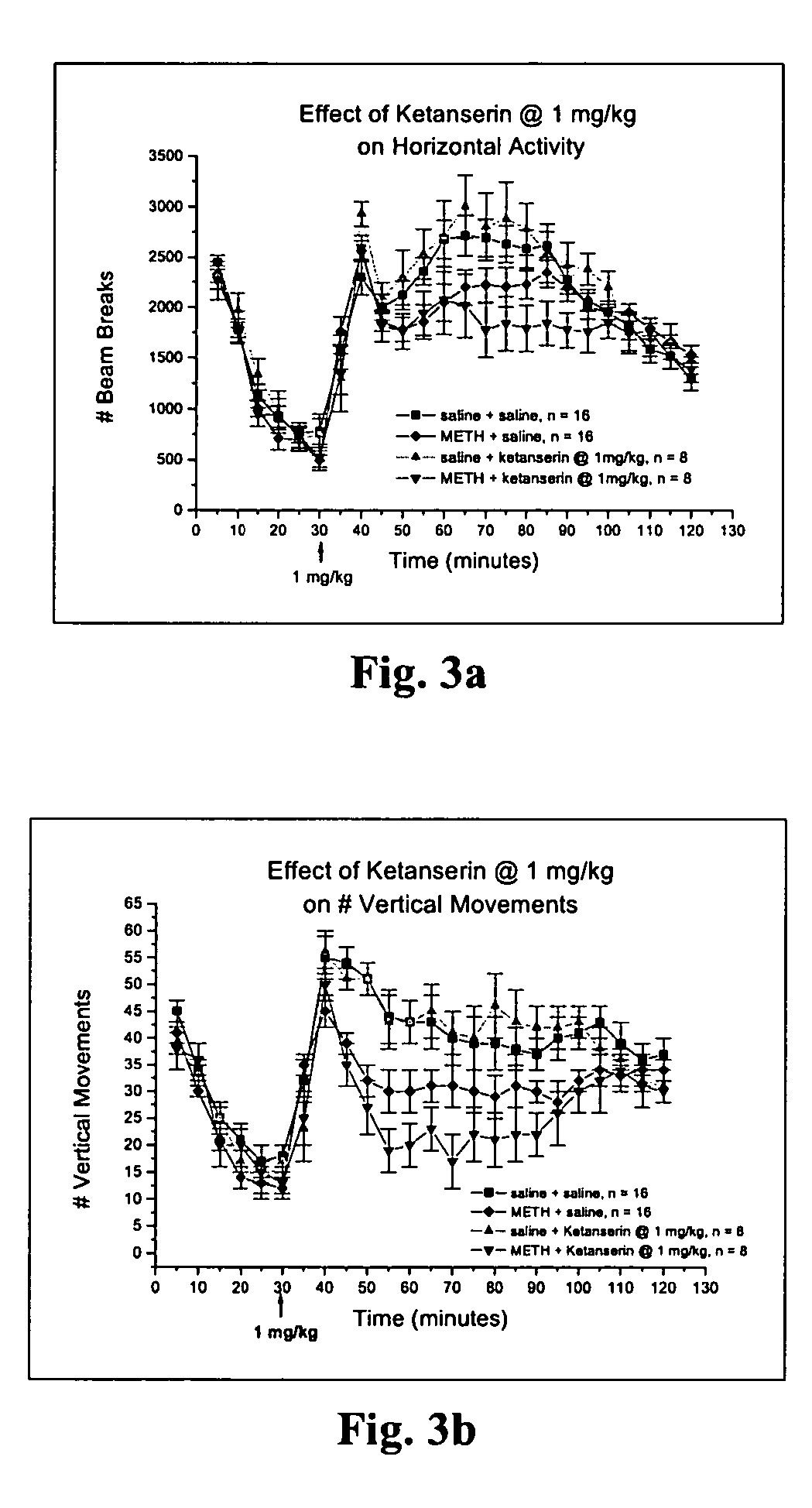Treatment for methamphetamine addiction and reduction of methamphetamine use using serotonin antagonists
- Summary
- Abstract
- Description
- Claims
- Application Information
AI Technical Summary
Benefits of technology
Problems solved by technology
Method used
Image
Examples
example i
Methamphetamine-induced behavioral sensitization.
[0085] Automation of observational evaluations was accomplished using computerized small animal monitors (AccuScan Instr. Inc., Columbus, Ohio). The sensitization profiles quantified by the AccuScan monitors in rats following 5, once-daily days of METH treatment (2.5 mg / kg) were found to mirror that observationally described for similarly treated rats. One feature of drug-induced behavioral sensitization is heterogeneity of motor responses and the AccuScan monitors quantify numerous behavioral indices. This is a critical point for the motor profile is exquisitely related to METH dose, the drug history of the rat and observation time. After 3- or 31-days of withdrawal from repeated METH injections, rats were allowed to achieve baseline motor activity with a 30 min habituation period, challenged with 1 mg / kg sc METH and monitored for 90 min. As shown in FIGS. 1a-b, a “sensitized” motor response was clearly expressed in the METH-pretre...
example ii
Methamphetamine-induced associative learning, as assessed by place conditioning.
[0095] Studies described in the studies of Example I helped identify mirtazapine as a 5-HT2A / 2C antagonist with a profile most likely to meet our objective of ameliorating the neuronal and behavioral effects of repeated METH exposure. To enhance the validity of the behavioral model of addiction, and thus to promote the ability of the rodent work to translate into the human condition, we developed a novel approach to assessing the behavioral consequences that incorporates a means to quantify the incentive properties of METH. As enhanced attribution of salience to METH is a key feature that drives a drug-withdrawn addict to again seek drug and to relapse into drug taking, the therapies of the present invention address this very feature. Incentive salience can be measured in rats using place conditioning procedures. Akin to the craving for METH that is evoked in human addicts when they are exposed to peop...
example iii
Gene transcription as brain region-specific markers for the effects for METH withdrawal and their reversal with 5-HT2A / 2C antagonists.
[0100] Receptor-mediated changes in cellular Ca2+ and cAMP can give rise to persistent neuroplastic changes through modulation of transcription factors and ensuing changes in gene transcription. Amphetamine and cocaine modify gene transcription through the phosphorylation and activation of CREB[33], or through ΔFosB, the level of which has been shown to be increased after chronic cocaine. To investigate whether METH also modifies the activity of CREB and levels of ΔFosB, we assayed for pCREB, CREB and ΔFosB (with Western blot techniques) in the frontal cortex, nucleus accumbens and ventral pallidum, harvested 3 and 14 days after repeated METH (2.5 mg / kg). The nucleus accumbens and ventral pallidum showed a decrease in the activation state of CREB (pCREB / CREB ratio) (FIG. 14) at 14 days withdrawal. In contrast, the frontal cortex showed elevated leve...
PUM
| Property | Measurement | Unit |
|---|---|---|
| Mass flow rate | aaaaa | aaaaa |
| Mass flow rate | aaaaa | aaaaa |
| Mass flow rate | aaaaa | aaaaa |
Abstract
Description
Claims
Application Information
 Login to View More
Login to View More - R&D
- Intellectual Property
- Life Sciences
- Materials
- Tech Scout
- Unparalleled Data Quality
- Higher Quality Content
- 60% Fewer Hallucinations
Browse by: Latest US Patents, China's latest patents, Technical Efficacy Thesaurus, Application Domain, Technology Topic, Popular Technical Reports.
© 2025 PatSnap. All rights reserved.Legal|Privacy policy|Modern Slavery Act Transparency Statement|Sitemap|About US| Contact US: help@patsnap.com



